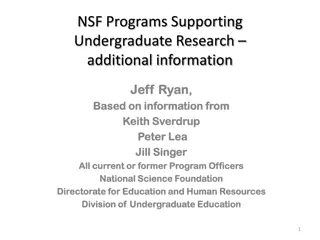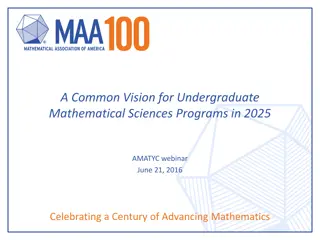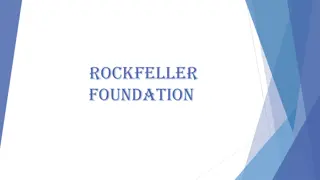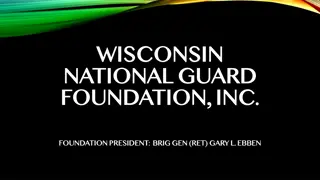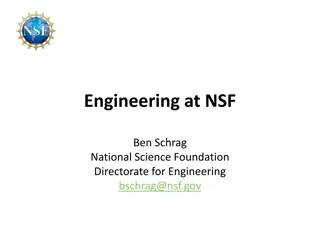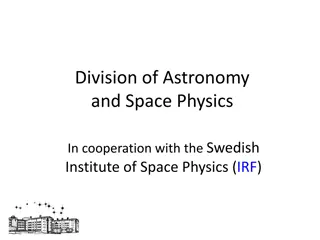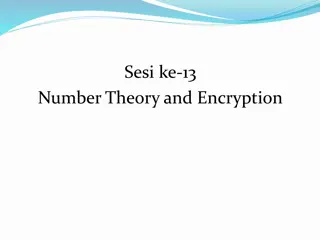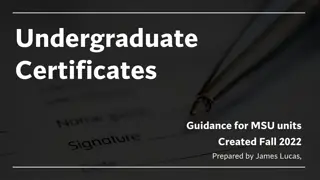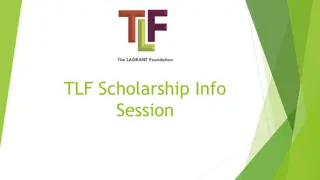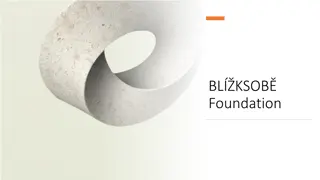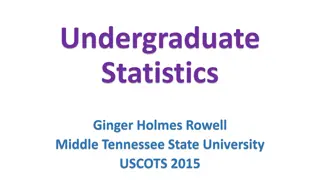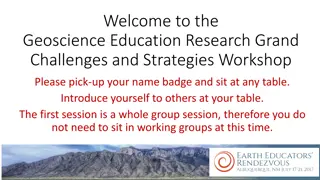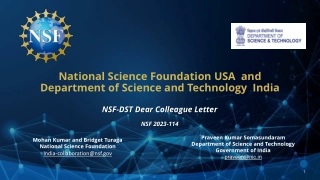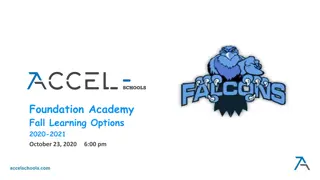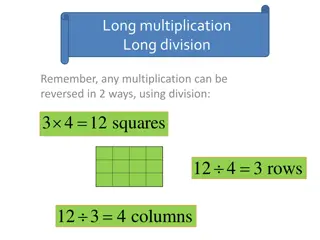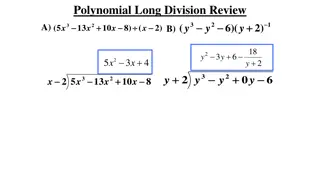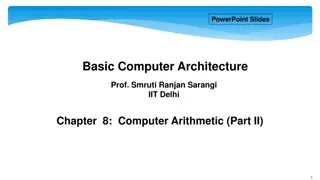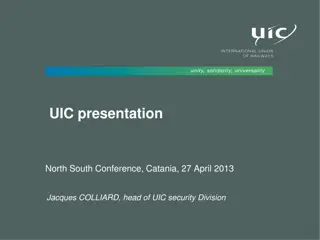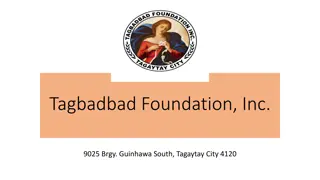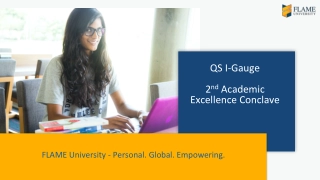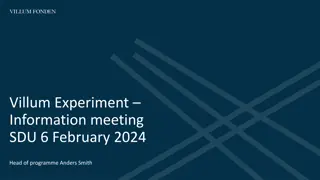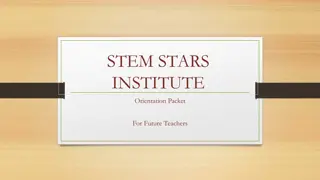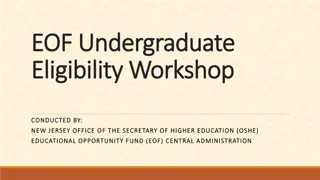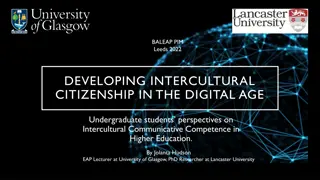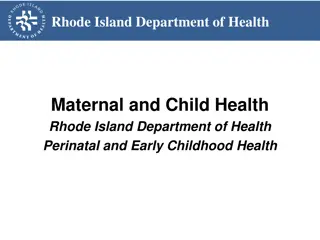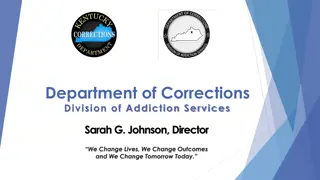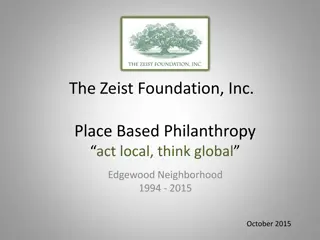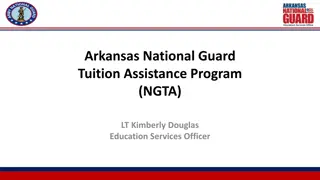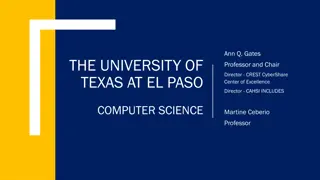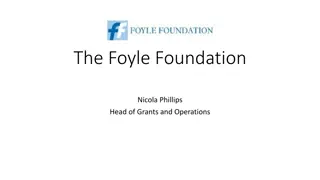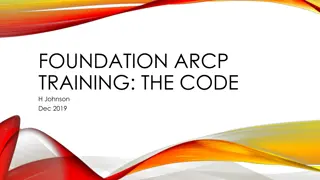National Science Foundation Division of Undergraduate Education (DUE) Programs
The National Science Foundation (NSF) Division of Undergraduate Education (DUE) offers various funding opportunities and programs to support science, technology, engineering, and mathematics (STEM) education. The DUE aims to enhance undergraduate education, produce more STEM graduates, and advance research in these fields. Programs like Research Experiences for Undergraduates (REU), Advanced Technological Education (ATE), and more are designed to support institutions, educators, and students in STEM disciplines.
Download Presentation

Please find below an Image/Link to download the presentation.
The content on the website is provided AS IS for your information and personal use only. It may not be sold, licensed, or shared on other websites without obtaining consent from the author. Download presentation by click this link. If you encounter any issues during the download, it is possible that the publisher has removed the file from their server.
E N D
Presentation Transcript
National Science Foundation Division of Undergraduate Education (DUE) NSF Funding Opportunities V. Celeste Carter and Tom Higgins vccarter@nsf.gov; thhiggin@nsf.gov Division of Undergraduate Education National Science Foundation Arlington, VA
National Science Foundation Division of Undergraduate Education (DUE) NSF by the Numbers $7.3 billion 1,859 FY 2015 appropriations (does not include mandatory accounts) Colleges, universities, and other institutions receiving NSF funding in FY 2015 Proposals evaluated in FY 2015 through a competitive merit review process Competitive awards funded in FY 2015 (24% success rate) 49,600 12,000 231,000 350,000 Proposal reviews conducted in FY 2015 Estimated number of people NSF supported directly in FY 2015 (researchers, postdoctoral fellows, trainees, teachers, and students)
National Science Foundation Division of Undergraduate Education (DUE) REPORT TO THE PRESIDENT ENGAGE TO EXCEL: PRODUCING ONE MILLION ADDITIONAL COLLEGE GRADUATES WITH DEGREES IN SCIENCE, TECHNOLOGY, ENGINEERING, AND MATHEMATICS President s Council of Advisors on Science and Technology February 2012 http://www.whitehouse.gov/sites/default/files/microsites/ostp/pc ast-engage-to-excel-final_2-25-12.pdf
National Science Foundation Division of Undergraduate Education (DUE) Where to Look for Programs Education and Human Resources (EHR) Division of Undergraduate Education (DUE) Human Resource Development (HRD) Division on Research and Learning (DRL) Cross Discipline Programs Research in Undergraduate Institutions (RUI) Research Experiences for Undergraduates (REU) Research Directorates: RCN-UBE (BIO) SBIR/STTR Program (Small Business Innovation Research/Small Business Technology Transfer)
National Science Foundation http://nsf.gov/div/index.jsp?div=DUE Division of Undergraduate Education (DUE)
National Science Foundation Division of Undergraduate Education (DUE) Advanced Technological Education (ATE) Program Focus: education of science and engineering technicians for advanced-technology fields that drive the nation s economy. Projects, Centers, Targeted Research on Technician Education Funding from $150,000-$4 million over all 3 tracks Grades 7-12, two-year and four-year institutions (Pathways). Community and technical colleges must be in leadership roles. Education / Industry/ Economic Development Agencies, WIBs Partnerships. Proposal Deadline: October 6, 2016.
National Science Foundation Division of Undergraduate Education (DUE) Finding Resources ATE Central www.atecentral.net ATE Centers www.atecenters.org Mentor Connect www.mentor-connect.org Evalu-ate Center www.evalu-ate.org SCATE: www.teachingtechnicians.org ATE TV www.atetv.org NSF Awards Database www.nsf.gov Awards tab on top of page Advanced search Enter search term(s) Enter Advanced Technological Education Program
National Science Foundation Division of Undergraduate Education (DUE) ATE Projects Projects: up to $300,000/yr for 3-yrs ($900,000 max. total) Small, New to ATE: up to $200,000 total over 2-3- yrs Mentor Connect (www.mentor-connect.org) ATE Coordination Networks: up to $200,000/yr for 4-yrs (session Thurs. 11:30 am)
ATE Investments National Science Foundation Division of Undergraduate Education (DUE) https://atecentral.net/ate20
1400650 An ATE Project National Science Foundation Division of Undergraduate Education (DUE) Mt. SAC STEM Teacher Preparation Program (STEM TP2) Mt. San Antonio College (Mt. SAC) is a federally-designated Hispanic-Serving Institution, and is the largest single campus of California's 112 community colleges. The campus is located about 30 miles east of Los Angeles. Two factors speak to the need for the preparation of more and better science and mathematics teachers in this area: student mathematics and science test scores for several of Mt. SAC's top feeder high schools are in need of improvement and there is a predicted dramatic attrition among the population of middle-school and high school teachers. To address the need for more and better science and mathematics teachers, Mt. SAC is developing a sustainable multidimensional program to recruit, counsel, and direct likely students that have the desire and potential to become highly-qualified middle school and high school mathematics and science teachers. The project, titled Mt. SAC STEM Teacher Preparation Program (STEM TP2), is providing the students with (1) a cluster of academic support, (2) enrichment activities, (3) teaching opportunities, and (4) authentic research experiences designed to promote student success.
National Science Foundation Division of Undergraduate Education (DUE) NSF Scholarships in STEM (S-STEM) Program Supports institutional scholarship programs for full-time, academically-talented students with financial need. Funds are provided through H1B visa fees. Strong proposals develop programs for cohorts of students that address local needs, and effectively mentor and support students to enable them to enter the STEM workforce or graduate school. Proposal Deadline: April 20, 2017 http://www.nsf.gov/pubs/2016/nsf16540/nsf16540.pdf
National Science Foundation Division of Undergraduate Education (DUE) S-STEM Strands Strand 1: S-STEM Institutional Capacity Building $650,000 over 5-yr, 60% funds go to scholarships work with offices of institutional research or researchers. Findings from these types of projects shall be used to improve local implementation of academic and student supports, provide an understanding of student success and inform any future proposals for S-STEM Design and Development Strand. Strand 2: S-STEM Design and Development Single Institution, $1 million over 5-yr, 60% scholarships Multi-Institutional Consortia, $5 million over 5-yr, 60% scholarships 2-yr 4-yr, or any combination in consortium
IUSE Program [NSF 15-585] http://www.nsf.gov/pubs/2015/nsf15585/nsf15585.pdf National Science Foundation Division of Undergraduate Education (DUE) IUSE emphasizes knowledge-based & knowledge-generating approaches. Two program tracks Institutional and Community Transformation Engaged Student Learning Two tiers Two tiers Design and Implementation (Larger Scope) Level I: Up to $600k, 3 yrs. Level II: $601k to $2M, 5 yrs. Design and Implementation (Larger Scope) Exploration (Smaller Scope) Exploration (Smaller Scope) Up to $300k, 3 yrs. Up to $300k, 3 yrs. Up to $3M, 5 yrs. Early Nov 2016 Mid-Jan 2017 Early Nov 2016 Mid-Jan 2017 Focus on design, development, implementation of and research on STEM learning models, approaches, and tools Focus on approaches to increase the propagation of highly effective methods of STEM teaching and learning
National Science Foundation Division of Undergraduate Education (DUE) NSF-IUSE Goals use and build evidence about improved STEM instructional practices; design and study innovative learning opportunities, including cyberlearning; create, implement, and test program, curricular, course, and technology-driven models; develop, implement, and test creative approaches for adoption of education research into disciplinary teachings; develop and validate assessments/metrics for undergraduate STEM learning and instructional practice; and conduct fundamental research on issues of undergraduate STEM teaching and learning.
National Science Foundation Division of Undergraduate Education (DUE) RISE - Research-based Interdisciplinary STEM Education Award ID DUE 1432018 PI: Kalyn Owens, North Seattle Community College Collaborative Project between N. Seattle CC and Central Washington University PROJECT GOAL - To use undergraduate research and interdisciplinary experiences as vehicles to cultivate meaningful thinking opportunities in the first and second years of the college experience. PROJECT OBJECTIVES a. Provide progressive and innovative STEM curriculum that significantly improves preparation of diverse student populations for upper level courses and careers in science b. Establish the foundation for a Pacific Northwest Collaboration focused on excellence in STEM education at the community college level c. Make a significant contribution to the body of knowledge regarding our understanding of how students think, learn, and problem solve in a research and interdisciplinary context early in the college experience
National Science Foundation Division of Undergraduate Education (DUE) Collaborative Research: Community College Undergraduate Research Initiative (CCURI); Award ID: 1118679 PI: James Hewlett, Finger Lakes Community College The Community College Undergraduate Research Initiative (CCURI - www.ccuri.org) is a national consortium of community colleges, four-year schools, government agencies, and private organizations dedicated to the development, implementation, and assessment of a sustainable model for integrating an undergraduate research (UR) experience into community college biology curriculum. In partnership with the Council on Undergraduate Research (CUR), CCURI has developed a fully-integrated model for integrating undergraduate research at a community college. This project aims to: 1) Expand a modified version of the CCURI model to 16 additional community colleges; 2) Implement a comprehensive evaluation of the CCURI model on student learning, competency, and retention in STEM; 3) Measure the impact of the CCURI model on developing institutional capacity at the 16 additional community colleges that are committed to developing an undergraduate research program; and 4) Disseminate the modified CCURI model of integration and the customized versions of the model as they exist at the institutional partners within CCURI.
National Science Foundation Division of Undergraduate Education (DUE) Research Collaborations with SBIR/STTR Phase II Grantees http://www.nsf.gov/eng/iip/sbir/portfolio/researchexp.jsp Community College Students and Teams Partnership funding between small businesses and community college researchers and students. Max Funding: $40,000 per year Deadline: Rolling submission; submission 3 months before target start date is suggested
NSF PAPPG National Science Foundation Division of Undergraduate Education (DUE) Part I: Grant Proposal Guide (GPG) and Part II: Award & Administration Guide (AAG) Grant Proposal Guide (GPG) Chapter I: Pre-submission Information Chapter II: Proposal Preparation Instructions Chapter III: NSF Proposal Processing and Review Chapter IV: Non-Award Decisions and Transactions Chapter V: Renewal Proposals Award & Administration Guide (AAG) Chapter I: NSF Awards Chapter II: Grant Administration Chapter III: Financial Requirements and Payments Chapter IV: Grantee Standards Chapter V: Allowability of Costs Chapter VI: Other Post Award Requirements Chapter VII: Grant Admin. Disputes and Misconduct
National Science Foundation Division of Undergraduate Education (DUE) The Program Solicitation Program Description Program-specific considerations & restrictions Institutional Eligibility & Limitations PI Eligibility & Limitations Budgetary Limitations Submission Deadlines & Target Dates Resources for proposal preparation Program Director Contact Information
*Never received an award OR no award within 5-yrs OR never reviewed by CAAR National Science Foundation Division of Undergraduate Education (DUE) New Performers* Submit a proposal Merit Review Begins negotiation with PI to resolve questions and concerns (intends to recommend for award) Ratings and Program Officer review Program Officer (PO) then does 2 things Sends proposal to Division of Grants and Agreements (DGA) DGA sends New Performer Package to Institution Institution completes package DGA DGA notifies PO recommend award Cost Analysis & Audit Resolution (CAAR) DGA Declines & De-briefs Institution
National Science Foundation Division of Undergraduate Education (DUE) Questions?


